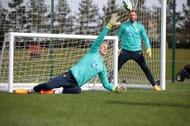When Sheik Mansour took over Manchester City Football Club in 2008, he promised to transform the club’s fortunes in the years to come and carry them out of the shadow of their fierce and much more successful rivals Manchester United. More importantly, he swore to make them worthy challengers for domestic and continental trophies.
Fast forward to 2015, seven years into the project initiated by the Abu Dhabi United Group, and things don’t seem as glorious as were anticipated. Yes, City have become noisier in the city of Manchester, and they’ve won two league titles – their first since 1968 – but the club is yet to attain an aura of stability, surety and consistency.
Some attribute City’s inconsistency to the change of managers, with three of them – Mark Hughes, Roberto Mancini and the incumbent Manuel Pellegrini – all being at the helm in a space of just seven seasons. But the factor which has a greater role to play in City’s start-stop journey since the takeover is their imprudent transfer policy, lacking any long-term vision or strategic planning.
It’s easy for wealthy owners to make treasure chests available during transfer windows, but for managers, scouts and club directors to judiciously and acutely utilize the available funds is a different ball-game altogether. And the transfer market has been one area where City have run around like headless chickens, with no tangible purpose or vision.
The fact that their current squad consists of just two English players, and has the highest average age out of all top flight teams last season, with Sergio Aguero (then 26) being the youngest player to start the Champions League knockout stage match against Barcelona this year, bears perfect testament to all that has gone wrong with City’s transfer policy over the years.
Usually when clubs falter with their transfer strategies, it is because of one particular aspect that goes wrong – lack of focus on a particular department, over-reliance on youngsters, too many changes too soon, etc. But in City’s case, it seems like almost everything has gone wrong at the same time.
Lack of homegrown players and a virtually non-existent domestic scouting network
With James Milner moving to Liverpool on a free transfer, the only senior English players left in the current City squad are the two goalkeepers – Joe Hart and Richard Wright. City’s homegrown scouting network is probably the weakest among all the big clubs in England.
They rarely pursue top English players, and their choice of domestic signings over the last few seasons has been pretty average. Scott Sinclair, Jack Rodwell, Gareth Barry, Joleon Lescott are hardly the kind of players any other big English club would look to sign. Moreover, all these players came with hefty price tags, could never establish themselves in the team and ultimately left the club for much more humble surroundings.
All this time, England have produced a fantastic crop of young players – the likes of Luke Shaw, Phil Jones, Nathaniel Clyne, Callum Chambers et al. City never came close to signing any of these players despite having the cash in the bag and the attraction of playing Champions League football.
Below-par academy talent
Sheikh Mansour has laid special emphasis on City’s academy and the need to scout and cultivate local talent. So much so that close to £200 million has been pumped into the academy project including a plush new facility.
But in spite of all the investment, barely any notable names have come up from the City academy in the last few seasons. Karim Rekik and Abdul Razzak have come closest to the first team, but even they have faded into obscurity in the last couple of seasons.
With all their financial muscle, City can’t even boast of having any precocious teenagers or wonder kids in their youth setup, even of other nationalities. This glaring deficiency is amplified when you compare City with how other big English clubs have invested in young talent, both in-house and through the transfer market.
Players like James Wilson, Luke Shaw, Tyler Blackett, Paddy McNair (Manchester United); Kurt Zouma, Oscar, Thibaut Courtois (Chelsea); Jack Wilshere, Aaron Ramsey, Kieran Gibbs, Hector Bellerin (Arsenal); Harry Kane, Kyle Walker, Eric Dier, Danny Rose (Tottenam); Raheem Sterling, Jordan Henderson, Philippe Coutinho (Liverpool) are established or recognizable names in the Premier League.
Too many players for the same position
Like the mighty Real Madrid, City too had an emphatic plan of having two world class players for every position. But unlike the Spanish giants, they have failed miserably on this front.
In the 2013/14 season, they had four world-class strikers (Sergio Aguero, Edin Dzeko, Alvaro Negredo and Steven Jovetic) in the squad jostling for one starting position. Some might point to their league triumph that season, but the sudden downfall of Manchester United under David Moyes, and Jose Mourinho’s first season after his return to Chelsea were two big factors that played into City’s hands.
At one point in the last two seasons, the likes of Matija Nastasic, Joleon Lescott and Martin Demichelis were competing for one starting berth in defence, alongside Vincent Kompany. Javi Garcia, who barely got to play in his natural defensive midfielder role, was turned into a centre back. Edin Dzeko still cuts a frustrated figure in a Manchester City shirt because he has to play second-fiddle in spite of repeatedly proving himself as a prolific goal-scorer when given the opportunity.
Inflating market value of players while buying, bad negotiators when it comes to selling
City have spent close to £500 million on buying players since 2008, more than a million pounds for every league point they have earned since then. This heedless outpouring of money attracted a Financial Fair Policy (FFP) penalty of £40 million last season apart from severe squad and transfer restrictions.
Their no-holds-barred approach in conducting transfer business is reflected in the extremely inflated amounts they’ve spent on players who can’t even be described as world-class. Some of these outrageous buys include Joleon Lescott (£22m), Emmanuel Adebayor (£25m), Kolo Toure (£16m), Roque Santa Cruz (£17.5m), Gareth Barry (£12m), James Milner (£26m), Jesus Navas (£22m) and Steven Jovetic (£26m).
A handful of European clubs have taught the world that buying big may not drastically impact a club’s finances if you can be shrewd while selling. Porto and Atletico Madrid have been masters of this business. But even on this front, City’s bosses have once again shown blatant ignorance and recklessness.
The highest sale fee they’ve received since 2008 is for Robinho (£22m). Here are the sale figures for some players who were sold when they were on the top of their game – Nigel De Jong (£3.5m), Mario Balotelli (£17m), Adebayor (£5m) and Carlos Tevez (£12m).
No vision
A football transfer is not an impulsive business. Players are bought keeping in mind a vision, be it short-term (Robin van Persie to Manchester United) or long-term (Eden Hazard and Diego Costa to Chelsea). At Manchester City, players are brought in at inflated prices without any real vision but on extremely short-term and avoidable needs.
Case-in-point: Wilfried Bony. Sergio Aguero had suffered an injury, but even having the likes of Dzeko and Jovetic for cover didn’t satisfy Manuel Pellegrini, who spent £28 million on a player who wasn’t even available for immediate selection owing to his national duty at the African Cup of Nations.
Their transfer policy lacks clarity or any kind of structure. Barcelona and Bayern Munich buy top talent to fit around a core group of homegrown players, Real Madrid buy the best in the business, Manchester United buy for the future and Chelsea make the best bargains. One can’t really describe City’s policy in a similar tone.
Their core group (David Silva, Sergio Aguero, Yaya Toure, Vincent Kompany, Joe Hart and Pablo Zabaleta) might serve as a point of stability and continuity, but the rest of the squad is too fragile with players coming in and going out every six months or every season.
The future doesn’t look any better
Even with the FFP penalties lifted, City can’t afford to spend big as UEFA will continue to monitor the club’s finances. Taking a cautious approach would mean that they might need to sell off one or more of their big-name players (like Samir Nasri or Yaya Toure).
City’s imprudent expenditure in the last few seasons has left them with very few homegrown players for the upcoming season. With the Premier League guidelines requiring a minimum of eight home-grown players in the squad of 25, City will now have to buy English players (again, at inflated prices) out of compulsion. The figures being speculated for Raheem Sterling have already given enough evidence of that.
With no potentially big names coming through from the academy to act as cover for the first-team, let alone challenge for a starting spot, all types of reinforcements and injection of fresh players have to come from the transfer market. City’s current squad is not getting any younger and as their rivals continue to invest heavily, expect City to show some desperation in the coming weeks.
On the surface, City’s woes might seem like an amalgamation of several different problems, but it is only when you go deep down that the real reasons for their inconsistency start appearing. They might have won two Premier League titles with all their money, but there is definitely a reason why they have always failed to make any sort of impact in European competitions.
You don’t just buy talent, you invest in it. Clearly, money isn’t everything in football.





